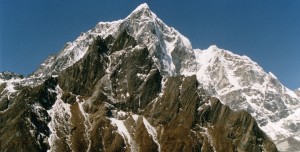Many Nepalese mountains, particularly in the Khumbu region, have become very popular tourist destinations. In the shadow of the 8000er-giants, there is a vast landscape of mountains, once inaccessible and remote and now in easy reach. “Trekking Peaks” – a term that suggest you can bring your happy meal for the ascent and surely makes Messner shiver whenever you use it – are part of many all-inclusive tourist packages. This has lead mountaineers to lament the downfall of adventure and the end of traditional mountaineering – a complaint that has been resurfacing over decades.
Without debating the validity of those claims, a serious question can be raised: What can we still gain from an expedition that has been done before many times? Does it even still qualify as ‘an adventure’? The response of professional mountaineers is to seek new and greater challenges. But those are mostly out of reach for amateurs. Is there a point in repeating previous experiences? No doubt, the nature of such an endeavor is changed when the question is not if it can be done but if it can be done this time by a particular climber. A transition from the general to the specific. No longer the ‘crystal horizon’. Yet it might still deliver insights that have broader implications and are not just significant to the individual. Or so one could argue.
This is the question I have been asking for the last few months and I’ll be looking for an answer this spring. The experiment is straightforward: look for a popular but at least somewhat challenging target and evaluate the experience. The objective is a well known peak not far from Everest: Lobuche East. 6119m high, it has been summited many, many, many times since the first ascent in 1984. With a PD+ rating, the normal route is not technically demanding. But even Gerlinde Kaltenbrunner considers it stunning. So what’s in it?

A crucial parameter of the experiment is to treat it seriously. This means thorough planning and preparation, whether it relates to gear, physical training or safety. And careful documentation. Okay, that sounds dry, like the old days when expeditions had a full-time chronicler. Let’s just say that means pictures, stories, interviews and hopefully many other interesting things.